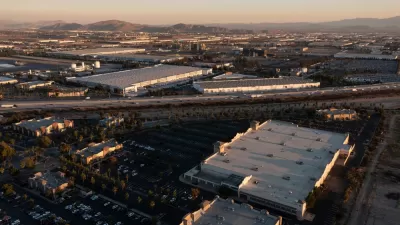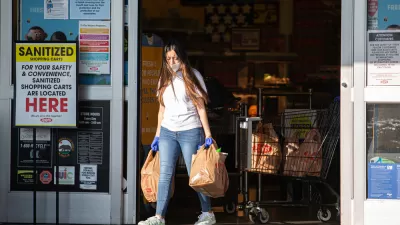Often located in low-income communities of color, Amazon's warehouses contribute to public health impacts like poor air quality, noise pollution, and traffic congestion.

An investigation from Consumer Reports uncovered that most neighborhoods where Amazon builds its warehouses are home to more people of color and low-income households than other neighborhoods in the same areas—and that this choice has powerful consequences for local residents. According to an article by Kaveh Waddell, "Residents near the new warehouses say they face increased air pollution from trucks and vans, more dangerous streets for kids walking or biking, and other quality-of-life issues, such as clogged traffic and near-constant noise."
According to the investigation's findings, "the neighborhoods where Amazon opens warehouses often have a greater proportion of people of color than 70 percent or more of the surrounding metro area’s neighborhoods." Meanwhile, the company's retail stores, such as Whole Foods, are more often located in "wealthier, whiter neighborhoods."
The article details the health impacts of truck traffic and pollution and the disproportionate influence of Amazon in the growing delivery industry. In many cases, the company receives tax incentives to build warehouses, effectively receiving subsidies from the very communities their operations harm.
In response to concerns about impacts on neighborhoods and labor issues, some cities in Southern California's Inland Empire have passed moratoriums on new warehouses, and the state's attorney general sued to stop the construction of a (non-Amazon) warehouse project. And while Amazon has promised to electrify its delivery truck fleet, that change would not mitigate the effects of heavy trucks lumbering down residential streets and, in some cases, causing physical damage to adjacent homes.
As Amazon's need for more warehouses continues to grow, the company is now buying real estate rather than leasing it to capture more of the value created by their properties.
FULL STORY: When Amazon Expands, These Communities Pay the Price

Study: Maui’s Plan to Convert Vacation Rentals to Long-Term Housing Could Cause Nearly $1 Billion Economic Loss
The plan would reduce visitor accommodation by 25,% resulting in 1,900 jobs lost.

North Texas Transit Leaders Tout Benefits of TOD for Growing Region
At a summit focused on transit-oriented development, policymakers discussed how North Texas’ expanded light rail system can serve as a tool for economic growth.

Why Should We Subsidize Public Transportation?
Many public transit agencies face financial stress due to rising costs, declining fare revenue, and declining subsidies. Transit advocates must provide a strong business case for increasing public transit funding.

How to Make US Trains Faster
Changes to boarding platforms and a switch to electric trains could improve U.S. passenger rail service without the added cost of high-speed rail.

Columbia’s Revitalized ‘Loop’ Is a Hub for Local Entrepreneurs
A focus on small businesses is helping a commercial corridor in Columbia, Missouri thrive.

Invasive Insect Threatens Minnesota’s Ash Forests
The Emerald Ash Borer is a rapidly spreading invasive pest threatening Minnesota’s ash trees, and homeowners are encouraged to plant diverse replacement species, avoid moving ash firewood, and monitor for signs of infestation.
Urban Design for Planners 1: Software Tools
This six-course series explores essential urban design concepts using open source software and equips planners with the tools they need to participate fully in the urban design process.
Planning for Universal Design
Learn the tools for implementing Universal Design in planning regulations.
City of Santa Clarita
Ascent Environmental
Institute for Housing and Urban Development Studies (IHS)
City of Grandview
Harvard GSD Executive Education
Toledo-Lucas County Plan Commissions
Salt Lake City
NYU Wagner Graduate School of Public Service





























